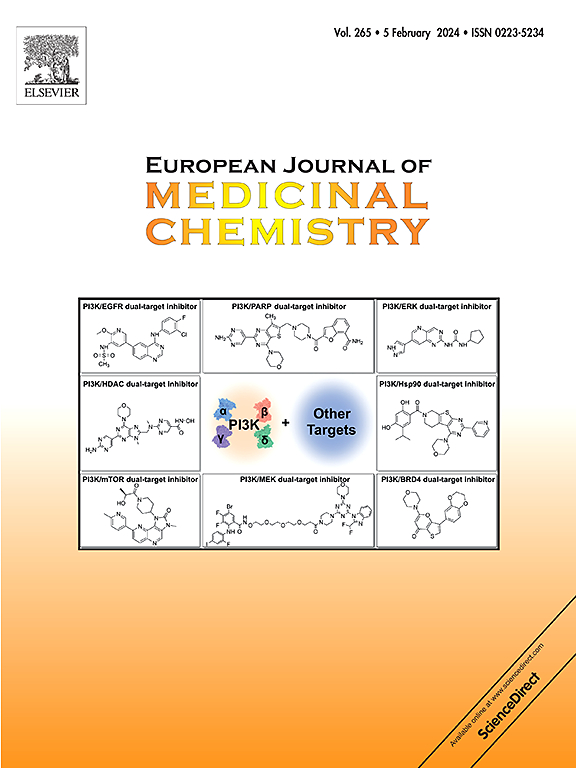Synthesis and antimicrobial evaluation of novel quaternary quinolone derivatives with low toxicity and anti-biofilm activity
IF 5.9
2区 医学
Q1 CHEMISTRY, MEDICINAL
引用次数: 0
Abstract
To overcome the increasing global drug resistance, the development of novel antimicrobial drugs is a top priority in the fight against multidrug resistant (MDR) and persistent bacteria. In this work, we report the synthesis of novel single quaternary quinolone antibacterial agents. The majority of the tested compounds exhibited significant antimicrobial efficacy against Gram-negative pathogens (E. coli and S. maltophilia). Notably, the selected compound (4e) was highly inhibitory with a MIC value of 0.25 μg/mL against E. coli. Additionally, compound 4e demonstrated excellent stability in complex biological fluids with low hemolytic activity (HC50 > 1280 μg/mL) and a significantly lower propensity to induce bacterial resistance. Encouragingly, 4e showed not only rapid bactericidal activity and inhibition of bacterial biofilms, but also low toxicity to erythrocytes and RAW 264.7 cells compared to the clinical drug ciprofloxacin. Mechanism studies have found that compound 4e has a relatively weak destructive effect on the cell membrane of E. coli.
However, it can effectively inhibit the activity of glutathione (GSH), promote the massive accumulation of intracellular reactive oxygen species (ROS), and then disrupt the antioxidant defense system of bacteria, achieving a bactericidal effect. In addition, compound 4e has a certain binding effect with bacterial DNA.

新型低毒抗生物膜季喹诺酮类衍生物的合成及抗菌评价。
为了克服全球日益增长的耐药性,开发新型抗菌药物是对抗耐多药(MDR)细菌和顽固细菌的当务之急。在这项工作中,我们报告了新型单季喹诺酮类抗菌剂的合成。大多数受试化合物对革兰氏阴性病原体(大肠杆菌和嗜麦芽糖酵母菌)具有显著的抗菌效果。值得注意的是,所选化合物(4e)对大肠杆菌具有高度抑制作用,其 MIC 值为 0.25 μg/mL。此外,化合物 4e 在复杂的生物液体中表现出极佳的稳定性,溶血活性低(HC50 > 1280 μg/mL),诱导细菌耐药性的倾向性也显著降低。令人鼓舞的是,与临床药物环丙沙星相比,4e 不仅具有快速的杀菌活性和抑制细菌生物膜的作用,而且对红细胞和 RAW 264.7 细胞的毒性较低。机理研究发现,化合物 4e 对大肠杆菌细胞膜的破坏作用相对较弱。但它能有效抑制谷胱甘肽(GSH)的活性,促进细胞内活性氧(ROS)的大量积累,进而破坏细菌的抗氧化防御系统,达到杀菌效果。此外,化合物 4e 与细菌 DNA 有一定的结合作用。
本文章由计算机程序翻译,如有差异,请以英文原文为准。
求助全文
约1分钟内获得全文
求助全文
来源期刊
CiteScore
11.70
自引率
9.00%
发文量
863
审稿时长
29 days
期刊介绍:
The European Journal of Medicinal Chemistry is a global journal that publishes studies on all aspects of medicinal chemistry. It provides a medium for publication of original papers and also welcomes critical review papers.
A typical paper would report on the organic synthesis, characterization and pharmacological evaluation of compounds. Other topics of interest are drug design, QSAR, molecular modeling, drug-receptor interactions, molecular aspects of drug metabolism, prodrug synthesis and drug targeting. The journal expects manuscripts to present the rational for a study, provide insight into the design of compounds or understanding of mechanism, or clarify the targets.

 求助内容:
求助内容: 应助结果提醒方式:
应助结果提醒方式:


